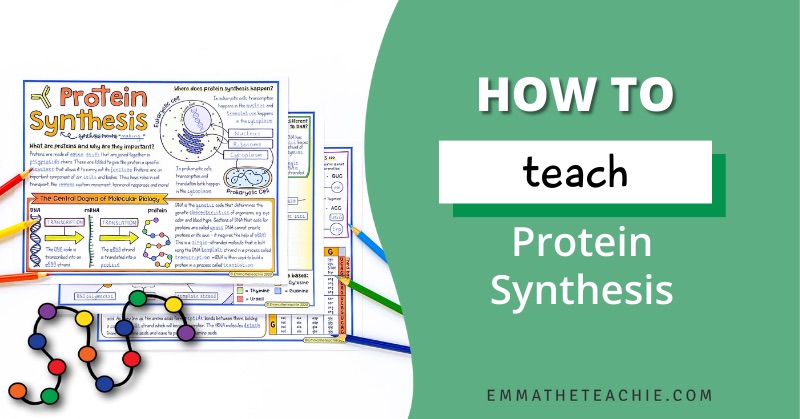
Fun and Effective Mutations Activities for High School Biology
Mutations are one of the most fascinating parts of biology.
Think about it…
Mutations can cause no change in an organism or they can cause extreme changes in an organism.
While many students also find mutations interesting, there can be a learning curve to remembering all of the different types of mutations.
I’m going to share some of the mutations activities I use in my lessons. These are fun for students, but also rigorous.
Side note: before you teach mutations, students should have an understanding of DNA replication, cell division, and protein synthesis.
Protein synthesis is a cornerstone of biology. Need ideas about how to teach protein synthesis? Check out this blog post and my protein synthesis activities.
Ok, now let’s take a look at my favorite teaching methods to help students grasp mutations.
Mutations Activities #1 – Telephone Mutations

Maybe it’s the nostalgia of playing Telephone at a sleepover in elementary school, but I love this activity.
Not only can I bask in the “old times,” but my students always get a kick out of this activity.
To play Telephone Mutations, have students line up in two or three lines, depending on the size of your class.
Whisper a short sentence to the first person in the line. Then, students have to whisper it in the ear of the person behind them, and so on.
Make it a rule that students cannot repeat themselves. They can only whisper the sentence once.
Once it reaches the end of each line, the last person shares with the class what they heard. You will not believe what the original sentence has turned into.
Some suggested sentences include, “The jazzy zebra decided to share high tea with the hairy hyena.” or, “My pig has a big pink wig”.
At the end, engage the class in a discussion about mutations.
Start by asking them which processes are done again and again in cells? (DNA replication and cell division).
How does this activity link to mutations in cells? (Sometimes mistakes are made when replicating a message).
When could this mistake/mutation happen? (Any time – at the start of the telephone line, the middle, or the end!)
From this, expand on what mutations are and what their results could be. Your students should be able to reach the conclusion that DNA mutations occur during DNA replication and chromosome mutations occur during cell division.
Try it. I promise you won’t be disappointed.
Mutations Activities #2 – Active reading

Students love reading!
I know… I’m hilarious and missed my comedy calling.
While our students may not like to read, reading is an important learning strategy in biology.
Simply put, students need to read. By reading, students can learn important reading comprehension skills and strategies that can be carried over into other science classes or other subjects.
I am such a believer in reading and writing in biology that I have a whole blog post about it. Check out all of the tips and strategies here.
In my Mutations Google Slides activity, I have included a couple of reading passages.
Students read the passage and answer three questions about mutations. In order to answer the questions, students are instructed to highlight the answers in specific colors.
The second reading passage instructs students to fill-in-the-blanks, where applicable. Students need to use context clues to finish the reading passage.
Since most students don’t like reading, it is important to keep the activities fresh and on the shorter end. If you do this, you are much more likely to keep the students’ attention.
Mutations Activities #3 – Inferencing with Mutations

Students don’t often realize that there are many types of mutations.
When they are made aware of this, there is sometimes a feeling of overwhelm with the different types and how they can remember everything.
Luckily for students, the names of mutations are similar to their functions.
Before I explain the types of mutations to students, I let them practice their inference skills with my Mutations Google Slides activities.
In this activity, students are given three types of mutations, insertion, substitution, and deletion. Next to each word, students are to write what they think each type of mutation means. I do remind them to use the word nucleotide in their definition since we have previously covered that information.
It is important to reiterate that students should not look up these definitions. It is solely based on their own knowledge.
Depending on my students, I will actually lock their site using our Chromebook management system. By doing so, students cannot navigate out of the activity.
Technology is great! 😁
After students share their ideas and we discuss the meanings of different mutations, I will have students apply their knowledge.
For instance, I will draw a strand of DNA on the board and ask for student volunteers to create an example of each mutation. Then, as a class, we can discuss whether that matches the definition of the mutation.
Mutations Activities #4 – Build Mutated DNA and mRNA

Once students have a basic understanding of mutations, they need to practice manipulating DNA.
In my Mutations Google Slides activity, students can do just that by dragging and dropping bases to build mutated strands of DNA and mRNA. The process of building them base by base really helps them understand the mutation.
After the mutations are created, students can use mRNA codon charts to work out the amino acids. At this point, students should have an understanding that mRNA codons code for a polypeptide strand.
For further analysis, students should compare the mutated polypeptide chains with the original. By doing this, students can see the effects of mutations on the final products.
We all know that technology isn’t always reliable or students forget their device.
If students don’t have their own devices or the Internet isn’t working, use a worksheet for the same type of assignment. Just make sure students have the opportunity to work out the mRNA mutation for themselves.
Mutations Activities #5 – Doodle Notes

Doodle Notes are a great activity to use for mutations.
It is easier for students to understand the types of mutations while doodling, as opposed to taking straight notes.
My mutations Doodle Notes include the type of DNA and chromosomal mutations, as well as the effects of mutations.
These can be differentiated, with multiple versions of the notes included.
If your students like doodling, then get them to draw the four types of mutations, and identify which is which. If they don’t like doodling, then the set of done-for-them Doodle Notes will work perfectly.
There is something for everyone!
You can let students work through them independently as a review, or you can use them to launch the topic by completing them together as a class!
If you are new to Doodle Notes, you can read more about how to use Doodle Notes here.
Let’s Unravel…

We can make learning about mutations fun for our students, while still ensuring rigor.
I think that using a variety of activities helps our students a) stay engaged, and b) have a better chance of gaining a deep understanding of mutations.
Hopefully you have enjoyed reading about these activities!
Don’t forget to check out my Mutations Google Slides activities and Mutations Doodle Notes. You won’t be disappointed.
And if you have any other suggestions for mutations activities, I would love to hear them. Just reply to any of my newsletter emails (and if you aren’t already signed up, you can do that here).
Have a wonderful day my friend,






